-
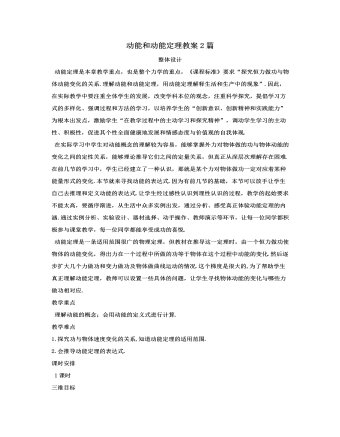
人教版新课标高中物理必修2动能和动能定理教案2篇
二、课堂教学(课前由科代表发回预习学案)1、教师根据预习学案检查结果提出问题(用多媒体展示),引导全班讨论(重点讨论:①、为什么动能的表达式一定是 mV2 ?你如何得出这个结论?②、力在一个过程中对物体所做的功,和物体在这个过程中动能的变化量有什么关系?你如何得出这个结论?这个做功的力和F=ma中的力F有什么关系)。有困难的小组应及时问老师。老师在这个过程中巡视指导。2、学生自主阅读课文“7 动能和动能定理”中的“动能的表达式”,然后完成如下练习(教师在此过程中巡视指导):2.1尝试推出动能的表达式(鼓励会推导的同学积极上台板演,老师引导讨论)。2.2写出动能的小结(认真阅读教材p66倒数第二段、第三段,结合你推导动能表达式的过程,认真思考后四人一组讨论:①、动能是矢量还是标量?②、动能的单位是什么?③、你认为应从哪几方面来理解动能?)
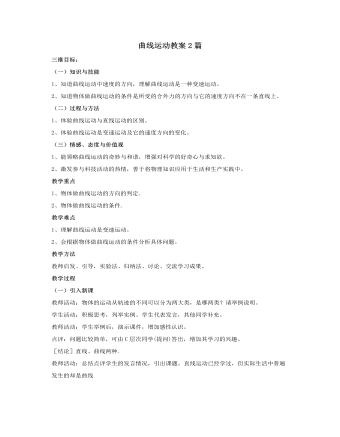
人教版新课标高中物理必修2曲线运动教案2篇
1、教师先演示投影:把小钢珠放在黑墨水瓶盖里转一下(内有一点点墨水),再放在半圆形有机玻璃轨道上运动并飞出,让钢珠在白纸上留下痕迹,同样在3/5半圆周,4/5半圆周上运动飞出,让学生猜测飞出方向由什么特点?(有机玻璃板说明:厚约5毫米,略小于小钢珠直径,圆弧半径15厘米,MN边稍长些,以便过MN做直线,根据半径大小确定圆心O位置。)学生猜想:切线方向师:已知圆弧半径为15厘米。如何验证?请用几何方法作图验证。生:标出飞出点和圆心,做圆心和飞出点的连线,用量角尺量出该连线和飞出轨迹直线的夹角,是否90度。2、再分组实验,提醒同桌配合,小心钢珠滚跑。实验完毕,要求作图验证,并互相讨论交流。3、交流和结论:师:要引导学生得出正确的科学结论:“圆周运动的物体的速度方向为该点的切线方向”,而不能直接得出“曲线运动的的物体速度方向为该点的切线方向”。
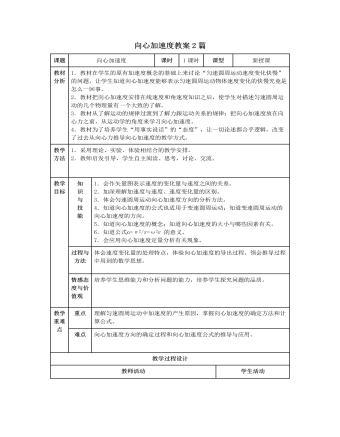
人教版新课标高中物理必修2向心加速度教案2篇
1.教材在学生的原有加速度概念的基础上来讨论“匀速圆周运动速度变化快慢”的问题,让学生知道向心加速度能够表示匀速圆周运动物体速度变化的快慢究竟是怎么一回事。2.教材把向心加速度安排在线速度和角速度知识之后,使学生对描述匀速圆周运动的几个物理量有一个大致的了解。3.教材从了解运动的规律过渡到了解力跟运动关系的规律;把向心加速度放在向心力之前,从运动学的角度来学习向心加速度。4.教材为了培养学生“用事实说话”的“态度”,让一切论述都合乎逻辑,改变了过去从向心力推导向心加速度的教学方式。1.采用理论、实验、体验相结合的教学安排。2.教师启发引导,学生自主阅读、思考,讨论、交流。知识与技能1.会作矢量图表示速度的变化量与速度之间的关系。2.加深理解加速度与速度、速度变化量的区别。3.体会匀速圆周运动向心加速度方向的分析方法。4.知道向心加速度的公式也适用于变速圆周运动;知道变速圆周运动的向心加速度的方向。
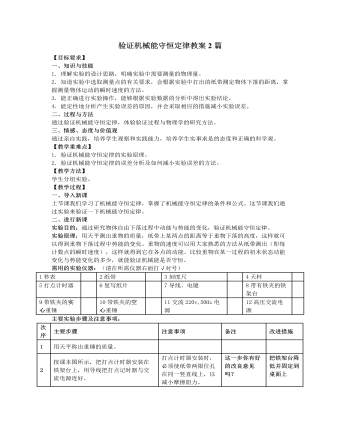
人教版新课标高中物理必修2验证机械能守恒定律教案2篇
教学目标㈠知识与技能1.要弄清实验目的,本实验为验证性实验,目的是利用重物的自由下落验证机械能守恒定律。2.要明确实验原理,掌握实验的操作方法与技巧、学会实验数据的采集与处理,能够进行实验误差的分析,从而使我们对机械能守恒定律的认识,不止停留在理论的推导上,而且还能够通过亲自操作和实际观测,从感性上增加认识,深化对机械能守恒定律的理解。3.要明确织带选取及测量瞬时速度简单而准确的方法。㈡过程与方法1.通过学生自主学习,培养学生设计实验、采集数据,处理数据及实验误差分析的能力。2.通过同学们的亲自操作和实际观测掌握实验的方法与技巧。3.通过对纸带的处理过程培养学生获取信息、处理信息的能力,体会处理问题的方法,领悟如何间接测一些不能直接测量的物理量的方法。
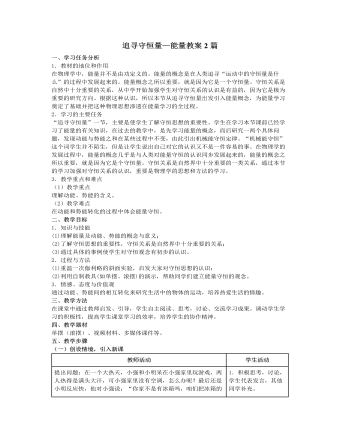
人教版新课标高中物理必修2追寻守恒量—能量教案2篇
一、学习任务分析1.教材的地位和作用在物理学中,能量并不是由功定义的。能量的概念是在人类追寻“运动中的守恒量是什么”的过程中发展起来的。能量概念之所以重要,就是因为它是一个守恒量。守恒关系是自然中十分重要的关系,从中学开始加强学生对守恒关系的认识是有益的,因为它是极为重要的研究方向。根据这种认识,所以本节从追寻守恒量出发引入能量概念,为能量学习奠定了基础并把这种物理思想渗透在能量学习的全过程。2.学习的主要任务“追寻守恒量”一节,主要是使学生了解守恒思想的重要性。学生在学习本节课前已经学习了能量的有关知识,在过去的教学中,是先学习能量的概念,而后研究一两个具体问题,发现动能与势能之和在某些过程中不变,由此引出机械能守恒定律。“机械能守恒”这个词学生并不陌生,但是让学生说出自己对它的认识又不是一件容易的事。
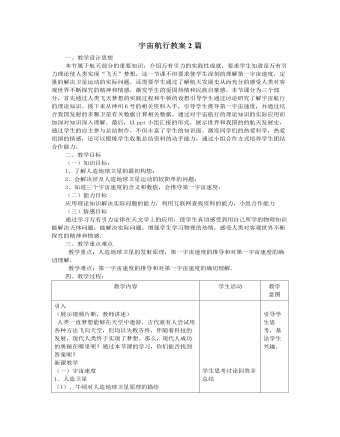
人教版新课标高中物理必修2宇宙航行教案2篇
动画展示三个宇宙速度(四) 让学生具有振兴中华的使命感与责任感本节课的最后,播放了一段美国登月的视频,让学生发现一些奇妙的物理现象,引导学生发现月球的背景是什么颜色,宇航员行走的模样等等,预计不久的将来,哪个国家也将登上月球,同学们高呼“中国”,那么我们现在能做些什么呢,让同学感想到:我们是祖国的未来的希望,现在需要努力学习科学文化知识,将来为祖国的航天事业做贡献。要培养学生坚韧不拨、勇于探索、协力合作的科学精神以及严谨求实、谦虚谨慎、勇于质疑科学态度;也要培养学习者热爱科学、热爱祖国的情感;努力学习、振兴中华的责任感。这些策略在本案例中得到了体现。(五)练习反馈,拓展延伸:[例题1]“2003年10月15日9时,我国神舟五号宇宙飞船在酒泉卫星发射中心成功发射,把我国第一位航天员杨利伟送入太空。飞船绕地球飞行14圈后,于10月16日6时23分安全降落在内蒙古主着陆场。”
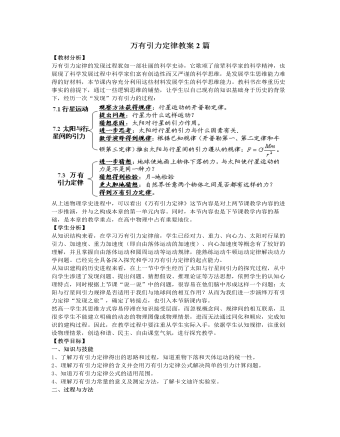
人教版新课标高中物理必修2万有引力定律教案2篇
3.适用条件(1)万有引力定律只适用于质点间引力大小的计算。当两物体间的距离远远大于每个物体的尺寸时,物体可以看成质点,直接使用万有引力定律计算。(模型)研究相互接触的两个人之间的万有引力时,不能把他们看作质点。(2)当两物体是质量均匀分布的球体时,它们间的引力也可直接用公式计算,但式中的r是指两球心间距离。研究太阳和地球之间的万有引力,可以把它们看作质量均匀的球体。当研究物体不能看成质点时,可以把物体假想分割成无数个质点,求出两个物体上每个质点与另一物体上所有质点的万有引力,然后求合力,这是微积分的思想。万有引力定律产生于对太阳系行星运动的研究,但它对物质运动的适用性却要广泛得多。可以这样说,宇宙中凡有引力参与的一切复杂的现象,无不要归结到这样一条十分简洁的定律之中,这不能不使人惊叹宇宙万物超乎寻常的和谐及人类理性思考所具有的统摄力。
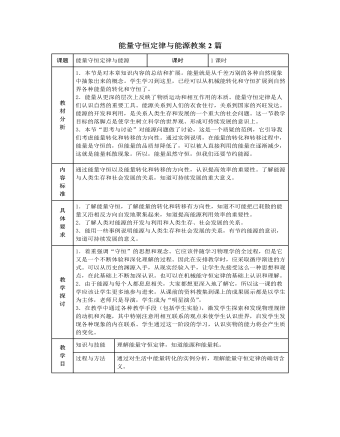
人教版新课标高中物理必修2能量守恒定律与能源教案2篇
世界能源问题的解决途径是什么?能源,是人类敕以生存和进行生产的不可缺少的资源.近年来,随着生产力的发展和能源消费的增长.能源问题已被列为世界上研究的重大问题之一.解决世界能源问题的根本途径,主要有两个方面:其一是广泛开源,其二是认真节流.所谓开源,就是积极开发和利用各种能源.在继续加紧石油勘探和寻找新的石油产地的同时,积极开发丰富的煤炭资源,还要大力开发水能,生物能等常规能源,加强核能、太阳能,风能、沼气,海洋能,地热能以及其他各种新能源的研究和利用,从而不断扩大人类的能源资源的种类和来源.所谓节流,就是要大力提倡节约能源.节能是世界上许多国家关心和研究的重要课题,甚至有人把节能称为世界的“第五大能源”,与煤、石油和天然气、水能、核能等并列.在节能方面,在有计划地控制人口增长的同时,重点要发挥先进科学技术的优势,提高各国的能源利用效率.
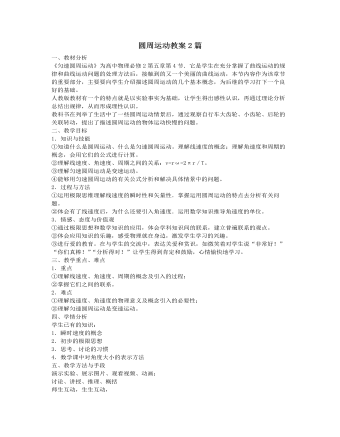
人教版新课标高中物理必修2圆周运动教案2篇
《匀速圆周运动》为高中物理必修2第五章第4节.它是学生在充分掌握了曲线运动的规律和曲线运动问题的处理方法后,接触到的又一个美丽的曲线运动,本节内容作为该章节的重要部分,主要要向学生介绍描述圆周运动的几个基本概念,为后继的学习打下一个良好的基础。人教版教材有一个的特点就是以实验事实为基础,让学生得出感性认识,再通过理论分析总结出规律,从而形成理性认识。教科书在列举了生活中了一些圆周运动情景后,通过观察自行车大齿轮、小齿轮、后轮的关联转动,提出了描述圆周运动的物体运动快慢的问题。二、教学目标1.知识与技能①知道什么是圆周运动、什么是匀速圆周运动。理解线速度的概念;理解角速度和周期的概念,会用它们的公式进行计算。②理解线速度、角速度、周期之间的关系:v=rω=2πr/T。③理解匀速圆周运动是变速运动。④能够用匀速圆周运动的有关公式分析和解决具体情景中的问题。
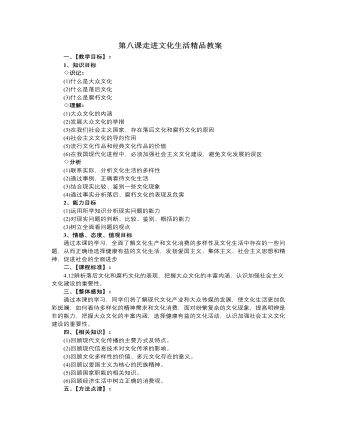
人教版高中政治必修3第八课走进文化生活精品教案
1.加强社会主义文化建设的必要性在人类历史的长河中,各种思想文化总是相互冲击、交汇、融合.奔腾向前,永不停息。今天,我们面对的文化有传统的和现代的、外来的和本土的、进步的和落后的、先进的和腐朽的、积极的和颓废的,等等。各种各样的文化有吸纳又有排斥,有融合又有斗争,有渗透又有抵御,呈现出前所未有的相互交织、相互激荡之势。在这种文化发展的大背景下,在我国现代化建设过程中,有必要弘扬我国社会主义的主流文化,这样有利于保证我国社会主义文化发展的方向。2.大力加强社会主义文化建设(1)中国特色社会主义文化在我国文化生活中处于主导地位。中国特色社会主义文化,始终坚持以科学的理论武装人,以正确的舆论引导人,以高尚的精神塑造人,以优秀的作品鼓舞人,无论是思想内容还是表现形式,都发挥着强有力的导向和示范作用。社会主义文化以其自身的科学性和先进性,并依靠社会主义政治和经济力量,在人民大众的文化生活中始终占据着主导地位。
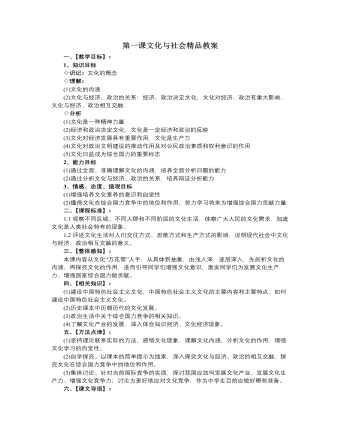
人教版高中政治必修3第一课文化与社会精品教案
(2)历史课本中历朝历代的文化发展。(3)政治生活中关于综合国力竞争的相关知识。(4)了解文化产业的发展,深入体会知识经济、文化经济现象。五、【方法点津】:(1)坚持理论联系实际的方法,感悟文化现象,理解文化内涵,分析文化的作用,增强文化学习的自觉性。(2)自学探究。以课本的简单提示为线索,深入探究文化与经济、政治的相互交融,探究文化在综合国力竞争中的地位和作用。(3)集体讨论。针对当前国际竞争的实质,探讨我国应如何发展文化产业、发展文化生产力、增强文化竞争力;讨沦为更好地应对文化竞争,作为中学生目前应做好哪些准备。六、【课文导语】:文化,一个我们十分熟悉的词汇。然而“熟知并非真知”。有人说,文化是知识;有人说,文化是艺术。究竟什么是“文化”?只要在社会生活中细细体味,我们就能真切地感悟“文化”的内涵与文化的力量。
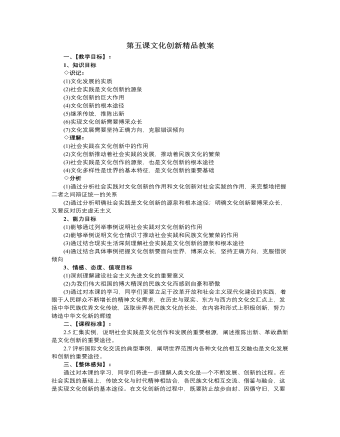
人教版高中政治必修3第五课文化创新精品教案
3.社会实践对文化创新的决定作用社会实践对文化创新具有两个方面的重要作用:(1)社会实践是文化创新的源泉实践,作为人们改造客观世界的活动,是一种有目的、有意识的社会性活动。人类在改造自然和社会的实践中,创造出自己特有的文化。离开了社会实践;文化就会成为无源之水、无本之木,人们不可能从事任何有价值的文化创造。◇本课小结:1.关于本课逻辑结构的宏观把握:文化创新的源泉和作用这一问题,教材分三个层次展开论证:一是不尽的源泉,不竭的动力;二是巨大的作用,深刻的意义;三是呼唤文化创新的时代。教材运用辩证方法从文化创新的源泉和作用展开论述。即社会实践是文化创新的源泉,文化创新又推动社会实践的发展和促进民族文化的繁荣。教材关于文化创新的途径问题,从三个层次展开讲述:第一个层次是“继承传统,推陈出新”;第二个层次是“面向世界,博采众长”;第三个层次是“坚持正确方向,克服错误倾向”。
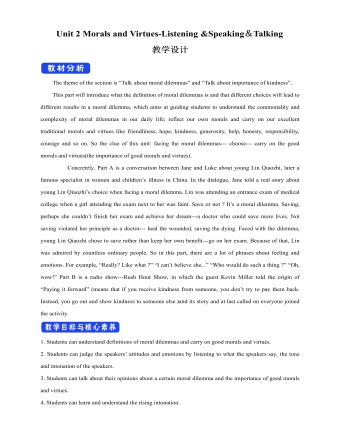
新人教版高中英语必修3Unit 2 Morals and Virtues-Listening &Speaking&Talking教学设计
Example:One day, a poor boy who was trying to pay his way through school by sending newspapers door to door found that he only had one dime(一角)left. He was so hungry that he decided to beg for a meal at the next house.However, he lost his nerve when a lovely young woman opened the door. Instead of a meal he asked for a drink of water. She thought he looked hungry so she brought him a large glass of milk. He drank it slowly, and then asked, “How much do I owe you?” “You don’t owe me anything,” she replied, “Mother has taught me never to accept pay for a kindness.” “Then I thank you from the bottom of my heart.” With these words, Howard Kelly left that house.Years later the woman became badly ill and was finally sent to the hospital in a big city. Dr. Howard Kelly, now famous, was called in. When he heard the name of the town she came from, a strange light filled his eyes. Dressed in his doctor’s clothes, Dr. Kelly went into her room and recognized her at once. From that day on, he gave special attention to her, and decided to do his best to save her life.At last the woman was saved. Dr. Kelly asked the business office to pass the final bill to him. He looked at it and then wrote something on the side. The bill was sent to the woman’s room. She was afraid to open it because she was sure that it would take the rest of her life to pay for it off. Finally she looked, and the note on the side of the bill caught her attention. She read these words: “Paid in full with a glass of milk, Dr. Howard Kelly.” Tear of joy flooded her eyes.
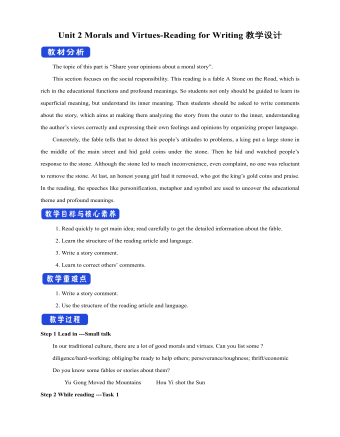
新人教版高中英语必修3Unit 2 Morals and Virtues-Reading for Writing教学设计
1. 这个寓言是一个关于一位国王古寓言。 The fable is an old fable about a king.2.作者用这个故事让读者对于社区的问题负有个人责任的必要印象深刻。The author used the story to impress upon readers with the need to take personal responsibility for problems in the community.3. 这个故事十分成功的实现了它的目的。The story was quite successful in achieving its purpose.Step 7 WritingPlease write a review of the story according the outline above.The fable is an old fable about a king who thought his people are lazy, so he put a large stone in the middle of the road and hides and waited to see if anyone will try to move it.The author used this story to impress upon readers with the need to take personal responsibility for problems in the community. The story was quite successful in achieving its purpose, and I liked it because it had a clear moral.However, while the moral of the story is clear, the actions of the king seemed pointless to me, because none of the characters in the story learnt anything. For this reason, I think there are better stories that can be used to impress upon people with the need for personal responsibility.Step 8 Pair workExchange drafts with a partner. Use this checklist to help your partner revise his/her draft.1. Does the writer give a short description of the story ?2. Does the description include the most important details of the story ?3. Does the writer give his or her opinion about the character or their actions ?4. Is the review well-organised ? 5. Does the writer use the -ing form as the adverbial correctly in the writing ?6. Are there any grammar, spelling, or punctuation errors ?Step 9 HomeworkPut up your revised draft in the classroom or read it to your class.
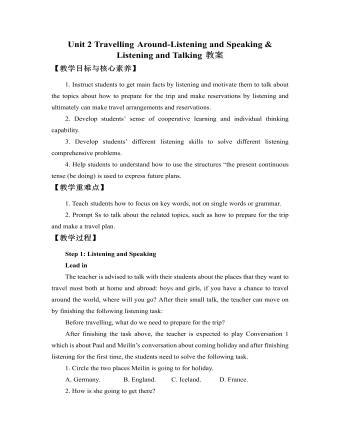
新人教版高中英语必修1Unit 2 Travelling Around-Listening and Speaking & Listening and Talking教案
【教学目标与核心素养】1. Instruct students to get main facts by listening and motivate them to talk about the topics about how to prepare for the trip and make reservations by listening and ultimately can make travel arrangements and reservations. 2. Develop students’ sense of cooperative learning and individual thinking capability. 3. Develop students’ different listening skills to solve different listening comprehensive problems.4. Help students to understand how to use the structures “the present continuous tense (be doing) is used to express future plans.【教学重难点】1. Teach students how to focus on key words, not on single words or grammar.2. Prompt Ss to talk about the related topics, such as how to prepare for the trip and make a travel plan.【教学过程】Step 1: Listening and SpeakingLead inThe teacher is advised to talk with their students about the places that they want to travel most both at home and abroad: boys and girls, if you have a chance to travel around the world, where will you go? After their small talk, the teacher can move on by finishing the following listening task:Before travelling, what do we need to prepare for the trip?
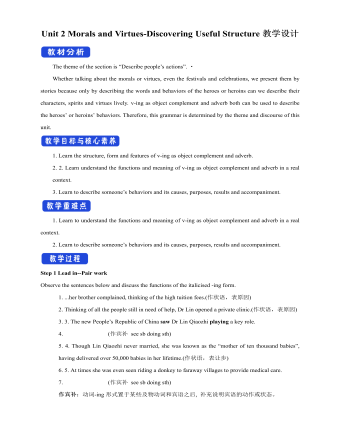
新人教版高中英语必修3Unit 2 Morals and Virtues-Discovering Useful Structure教学设计
1. 表示时间。Hearing these stories, I’m skeptical about the place. = When I heard these stories. . . 2. 表示原因。Not knowing his address, I can’t send this book to him. = Because/Since/As I don’t know his address. . . 3. 表示结果。His father died, leaving him a lot of money. =. . . and left him a lot of money4. 表示条件。Going straight down the road, you will find the department store. = If you go straight down the road. . . 5. 表示让步。Being tired, they went on working. =Although they were tired. . . 6. 表示行为方式、伴随情况或补充说明。He lay on the grass, staring at the sky for a long time. =. . . and stared at the sky for a long time注意:非谓语动词作状语时, 如所提供的动词不能和句子中的主语保持一致, 动词-ing形式必须有自己的逻辑主语, 通常由名词或代词来担任, 这就是独立主格结构。The last bus having gone, we had to walk home. (having gone的逻辑主语是the last bus, 而不是we)Weather permitting, the football match will be played on Friday. (permitting的逻辑主语是time, 而不是the football match)Step 7 Practice1. ________(study) hard, you are sure to get first prize. 2. People use plastic in their daily life, _______(leave) large amounts of waste. 3. ________(work) hard at your lessons, you are to succeed. 4. The old man, ____________(work) abroad for twenty years, is on the way back to his motherland. 5. ______________(finish) his homework, he was playing on the playground. Answers: 1. Studying 2. leaving 3. Working 4.having worked 5. Having finishedStep 8 HomeworkFinish the homework on Page 22.
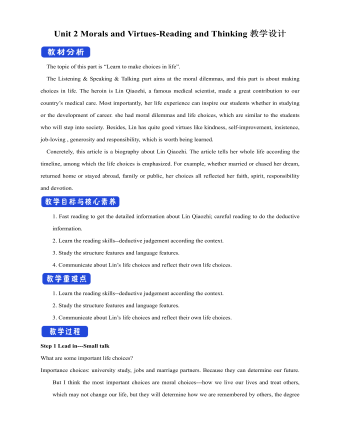
新人教版高中英语必修3Unit 2 Morals and Virtues-Reading and Thinking教学设计
The topic of this part is “Learn to make choices in life”.The Listening & Speaking & Talking part aims at the moral dilemmas, and this part is about making choices in life. The heroin is Lin Qiaozhi, a famous medical scientist, made a great contribution to our country’s medical care. Most importantly, her life experience can inspire our students whether in studying or the development of career. she had moral dilemmas and life choices, which are similar to the students who will step into society. Besides, Lin has quite good virtues like kindness, self-improvement, insistence, job-loving , generosity and responsibility, which is worth being learned.Concretely, this article is a biography about Lin Qiaozhi. The article tells her whole life according the timeline, among which the life choices is emphasized. For example, whether married or chased her dream, returned home or stayed abroad, family or public, her choices all reflected her faith, spirit, responsibility and devotion.1. Fast reading to get the detailed information about Lin Qiaozhi; careful reading to do the deductive information.2. Learn the reading skills--deductive judgement according the context.3. Study the structure features and language features. 4. Communicate about Lin’s life choices and reflect their own life choices.1. Learn the reading skills--deductive judgement according the context.2. Study the structure features and language features.3. Communicate about Lin’s life choices and reflect their own life choices.Step 1 Lead in---Small talkWhat are some important life choices?Importance choices: university study, jobs and marriage partners. Because they can determine our future.
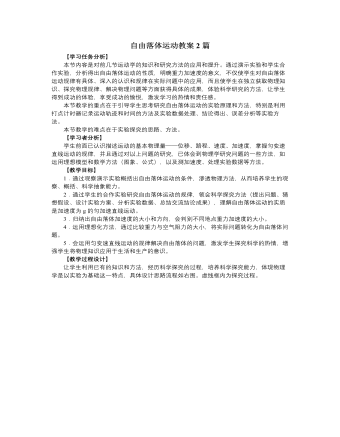
人教版新课标高中物理必修1自由落体运动教案2篇
演示实验1、将一张纸和一张金属片在同一高度同时释放,结果金属片先着地。教师不发表意见,继续做实验。分别将实验内容和实验结果板书在黑板上。2、将刚才的纸片紧紧捏成一团,再次与硬币同时释放,结果两者几乎同时落地。3、将两个完全一样的纸片,一个捏成团,一个平展,则纸团下落快。师:物体下落快慢是由质量决定吗?生:不是的!师:为什么这样说?生:第2个实验和第三实验都说明了这个问题,特别是第3个问题,质量一样却下落有快慢之分。师:那你现在觉得物体下落快慢由什么因素决定呢?生:我想应该是空气阻力。猜想师:如果影响物体下落快慢的因素是空气阻力,那么在没有空气阻力,物体的下落快慢应该是一样的,这种猜想是不是正确呢?我们来做一个实验验证一下。
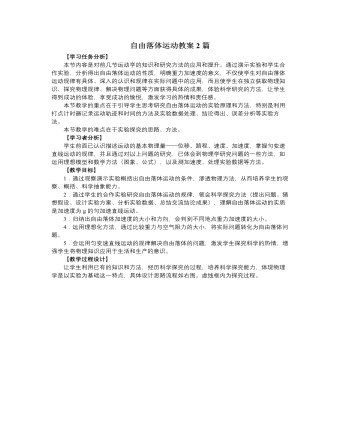
人教版新课标高中物理必修1自由落体运动教案2篇
教学重点1.自由落体运动的概念及探究自由落体运动的过程。2.掌握自由落体运动规律,并能运用其解决实际问题。教学难点演示实验和探究实验的技巧及自由落体运动规律的得出.教学过程设计思想:1、 先用游戏激发学生学习兴趣,顺理成章地研究落体运动;2、 通过演示实验让学生自己总结出物体下落快慢不同的主要原因是空气阻力,从而猜想若没有空气阻力会怎样;3、 用牛顿管实验验证猜想,引入了新的理想运动模型:自由落体运动。讲述1971年宇航员做的实验,加深印象;4、 了解地球表面物体下落运动近似成自由落体运动的条件;5、 着手研究自由落体运动的规律,利用打点计时器进行研究,得到结论;6、 总结自由落体运动特点及重力加速度;7、 应用训练
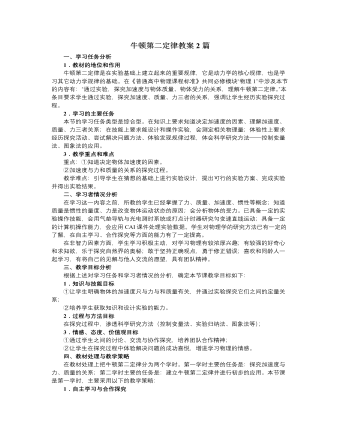
人教版新课标高中物理必修1牛顿第二定律教案2篇
1.这节课以实验为依据,采用控制变量的方法进行研究。这一方法今后在电学、热学的研究中还要用到。我们根据已掌握的知识设计实验、探索规律是物体研究的重要方法。2.定义力的单位“牛顿”使得k=1,得到牛顿第二定律的简单形式F=ma。使用简捷的数学语言表达物理规律是物理学的特征之一,但应知道它所对应的文字内容和意义。3.牛顿第二定律概括了运动和力的关系。物体所受合外力恒定,其加速度恒定;合外力为零,加速度为零。即合外力决定了加速度,而加速度影响着物体的运动情况。因此,牛顿第二定律是把前两章力和物体的运动构成一个整体,其中的纽带就是加速度。四、评价方案及说明1、对科学知识与技能的评价要注重科学内容的理解与应用,而不是单纯记忆。技能的评价目标包括观察技能、实验技能等方面。对科学的技能的评价要尽量融合在科学探究过程的情景中。对科学知识的评价主要从两方面,一是根据学生诊断性练习;二是通过学生作业反映学生掌握情况。





















